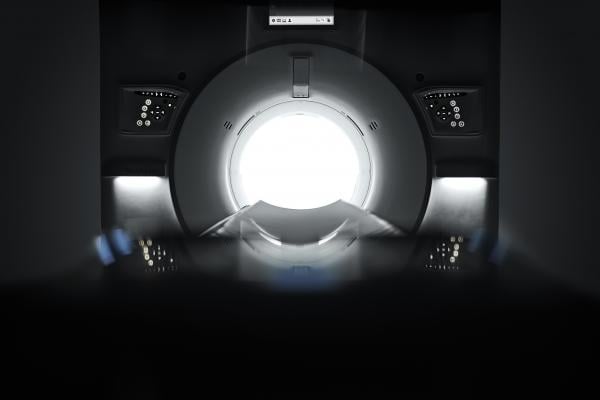
November 25, 2020 — GE Healthcare today announced its acquisition of Prismatic Sensors AB, a Swedish start-up specializing in photon counting detectors, signifying the company’s continued investment in photon counting CT technology. This technology has the potential to significantly increase clinical performance for oncology, cardiology, neurology, and many other clinical CT applications.
PCCT has the promise to further expand the clinical capabilities of traditional CT, including the visualization of minute details of organ structures, improved tissue characterization, more accurate material density measurement (or quantification) and lower radiation dose. Prismatic Sensors has overcome many challenges working with silicon and patented a novel way to position the silicon sensors “edge on” so the detector is deep enough to absorb very high energy photons and fast enough to count and quantify the energies of hundreds of millions of CT photons per second. The company was founded in 2012 as a spin-off from KTH Royal Institute of Technology in Stockholm, Sweden.
“We believe this technology has the potential to be a substantial step forward for CT imaging that will benefit millions of patients worldwide,” said Kieran Murphy, President & CEO, GE Healthcare. “From the first X-ray machines to the first photon counting CT prototype, GE Healthcare is committed to pioneering next generation technologies to achieve precision health and improve lives. We are excited about this cutting-edge approach with Deep Silicon and its clinical potential.”
“Our research shows Deep Silicon is the best solution for photon counting CT to meet clinical requirements,” said Mats Danielsson, Ph.D., CEO of Prismatic Sensors, “Silicon is by far the purest material produced for use in detectors. Alternative materials, including cadmium-based, face limitations as x-ray detector materials due to their imperfect crystal structure and contaminations. Silicon-based detectors will enable superior spectral resolution without compromising on count rate or spatial resolution. Our collaboration with GE Healthcare has been very productive and together, we have made rapid progress. Now, we look forward to the next chapter as we come together as one team working towards bringing photon counting CT with Deep Silicon detectors to the market.”
For nearly 50 years, CT has proven to be a vital imaging tool used by clinicians to detect cancer, heart conditions, and other diseases large and small. CT’s clinical use and diagnostic power have rapidly increased with the introduction of volumetric imaging, faster rotation speed, iterative and AI-based image reconstruction, dual energy, as well as dose reduction technologies. Last year, the United States reported an all-time high in CT procedure volume with an estimated 91.4 million scans[1]. Now, through GE’s dedication to CT innovation, photon counting CT technology has the potential to define the new standard of performance for premium CT systems for many years to come.
“It has been evident for decades that CT (and X-ray imaging) would benefit greatly from energy-discriminating photon counting detectors,” explains Norbert Pelc, Sc.D., Professor of Radiology, Emeritus at Stanford University. “The challenge has been developing detectors that can handle the very high photon flux from high-power x-ray tubes while delivering good energy resolution and maintaining or improving spatial resolution. Of course, the detectors also have to be manufacturable at reasonable cost. It is a huge testament to the scientists and engineers at Prismatic Sensors that they have achieved this. I expect the impact on the CT field will be large, for example, improved dose efficiency, particularly for low dose acquisitions and for applications that benefit from tissue specificity. To put the higher spatial resolution of this Deep Silicon detector in perspective, we have not seen a potential improvement of this magnitude in decades, and every other time that spatial resolution was improved significantly the utility of CT also advanced. This is very exciting.”
GE researchers began studying PCCT in 1993 and introduced the world’s first PCCT prototype using cadmium-based detectors in 2006. The company has been an industry leader in this technology for Nuclear Medicine for a decade, providing excellent results to clinicians and patients. Now, using Deep Silicon detectors, GE has identified a better solution for photon counting CT to accommodate the much higher count-rate demands of CT imaging, thereby providing much more information to clinicians.
“Clinicians rely on the information they receive from medical images – like those we receive from a CT – to help them correctly diagnose patients, monitor cases, and make treatment decisions,” explains Staffan Holmin, M.D., Professor in Clinical Neuroimaging, Karolinska Institutet and Senior Consultant at Karolinska University Hospital in Sweden. “What’s so exciting about photon counting CT technology is that it enables higher spatial resolution and contrast. This can help us to image small blood vessels, vascular pathologies, and to see malignant changes at an earlier stage when treatment can be more effective. The potential for substantially reduced radiation is also important, particularly for pediatric patients. Photon counting will likely become the new standard for all clinical applications where CT is used today.”
GE Healthcare expects to close the Prismatic Sensors acquisition by January 2021, after holding a minority position in the company since 2017. GE Healthcare and Prismatic Sensors will work together to deliver a clinical system in the near future[2]. Terms of the transaction are not disclosed.
For more information: www.ge.com


 December 17, 2025
December 17, 2025 









